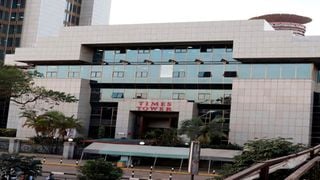
Times Tower, the KRA headquarters.
| File | Nation Media GroupBusiness
Premium
Ruling on minimum tax breaks Treasury’s promise to the IMF
Kenyan taxpayers are not off the hook yet, even after declaration of minimum tax as unconstitutional.
The Treasury had committed to the International Monetary Fund (IMF) that it would find alternative ways of plugging the revenue hole created by an unfavourable court ruling, such as the Monday judgement that declared minimum tax null and void.
According to national budget estimates, the Kenya Revenue Authority (KRA) was expected to collect Sh21 billion minimum tax this year.
The High Court however issued stay orders suspending its implementation on April 20th, before scrapping it altogether on Monday.
“The authorities did commit in the last discussions with them that in case the yield from minimum tax is substantially reduced it would take compensating measures and this reflects really the level of commitment the authorities have to achieving their tax revenue objectives”, IMF’s Mission Chief to Kenya, Mary Goodman, told the Nation in an interview.
The Treasury did not respond to our queries regarding the compensatory revenue measures it plans to pursue in line with its pledge to the IMF.
Loss-making businesses
Minimum tax would have seen businesses pay a one percent tax on sales, regardless of whether the enterprise was profitable or loss-making.
Justice George Odunga found the levy to be unfair to loss-making businesses, despite its noble intention of catching tax cheats who declare losses year-in-year-out.
The commitment by the government came on the back of the conclusion of the first review of the current Sh258 billion ($2.34 billion) loan program with the IMF, upon which the Treasury requested IMF to have the indicative target on tax collection modified. The indicative target on tax revenue was set at a floor of Sh996.2 billion for March 2021 and Sh1.4 trillion for June 2021, the end of the financial year.
“Based on the performance through April of the last fiscal year, the programme objective when it comes to tax revenue was slightly reduced. This reflected that while the authorities had taken important policy steps the yield on some of the tax measures in the midst of the full brunt of the pandemic were somewhat uncertain”, Ms Goodman said.
IMF programme
The IMF also extended the Kenyan government a breather on the structural benchmark that required it to implement a common payroll. While tapping into the IMF programme, the government committed to implement across ministries, departments, agencies, semi-autonomous agencies and counties a common payroll system that would be linked to the Integrated Financial Management Information System (IFMIS) by the end of June 2021.
“Kenya’s request relating to the program objective of implementing a common payroll system that is linked to IFMIS was granted. The initial benchmark aimed at issuing a decision across MDAs(ministries, departments and agencies), counties and SAGAS(semi-autonomous agencies). That was modified to focus on MDAs and Counties. The target date for that reform remains the same and we will discuss the status of this important reform in the upcoming mission that is planned,” said Ms Goodman.
The push for a common payroll system is designed to help manage Kenya’s ballooning wage bill and seal revenue leakage loopholes. According to the Salaries and Remuneration Commission, Kenya’s public-sector wage bill stands at Sh827 billion, gobbling up Sh51 of every Sh100 raised in ordinary revenue.
The IMF indicates that the change in the common payroll benchmark was informed by recognition that addressing issues in the public-sector payroll system is much more complex than earlier envisioned and would take considerable time. The Treasury did not also respond to questions regarding how far it is with the implementation of a common payroll system.





